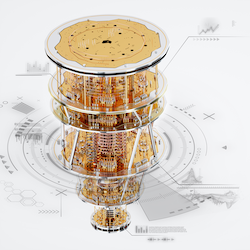By IEEE Computer Society Team
An Interview with Prof. Roshan Ragel – 2025 IEEE CS Mary Kenneth Keller Teaching Award Recipient As the first academic from the Global South to win the IEEE CS Mary Kenneth Keller Computer Science & Engineering Undergraduate Teaching Award, Prof. Roshan Ragel exemplifies leadership in teaching, research, and digital transformation. A Professor of…
By Vaibhav Pandey
The convergence of artificial intelligence (AI), machine learning (ML), and quantum computing unlocks groundbreaking advancements in software engineering. Quantum computing accelerates ML model training, solves complex optimization problems, and enables new AI architectures that classical computing struggles to support. At the same time, AI and ML are crucial in improving…
By Rambabu Bandam
Artificial intelligence (AI) has rapidly permeated every facet of modern life, seamlessly performing tasks ranging from trivial errands to complex decision-making processes. The allure of AI lies predominantly in its unmatched potential for efficiency, convenience, and accuracy. However, this unprecedented convenience brings with it a hidden yet profound threat: the…
By IEEE Computer Society Team
What drives a master inventor? If it’s IBM’s John Werner, it’s both voracious curiosity and a passion for solving real-world problems. These dual drives have resulted in more than 270 patents filed and 139 issued—and in Werner’s being named an IBM Master Inventor in 2018. Today, Werner is a Senior…
By IEEE Computer Society Team
We are aware of recent phishing emails impersonating Hironori Washizaki from a Gmail address. These messages are fraudulent and were not sent by the IEEE Computer Society. No internal systems have been breached. If you receive such an email, please delete it and do not respond. For questions or to…
By IEEE Computer Society Team
An interview with Yonghong Tian, recipient of the 2025 Hans Karlsson Standards Award Yonghong Tian stands as a global authority in the field of artificial intelligence and multimedia systems. Formerly serving as the Dean of the School of Electronics and Computer Engineering, now Vice-Dean of Peking University Shenzhen Graduate School…
By IEEE Computer Society Team
When launching a company, the decision about whether to go it alone or court investors is pivotal; Subodha Charles has done both and learned the many lessons that each path offers. Going it alone, for example, “teaches discipline like nothing else,” he says, and also underscores the importance of every…
By IEEE Computer Society Team
Corey Axelowitz has contributed to many groundbreaking design innovations, from the two-pound 12” MacBook to Plano AI’s early wildfire detection cameras that meld computer vision and modern hardware. He also played a pivotal role in the 10-month-to-mass-production development cycle for the huupe mini—the world’s first smart mini-basketball-hoop game console that…
By IEEE Computer Society Team
Two minutes into his TedX talk on AI and the environment, Tejas Chopra notes that training a single large language model releases roughly the same amount of carbon dioxide into Earth’s atmosphere as 125 roundtrip flights from New York to Beijing. In keeping with his ever-practical approach, Chopra goes on…
By Michael Martin
Digital twins—virtual models that simulate real-world city dynamics—are transforming urban transportation and mobility planning. These intelligent systems integrate real-time data, machine learning (ML) algorithms, and transportation research to optimize citywide solutions. By simulating traffic patterns, travel demand, and road dynamics, cities can make informed, equitable decisions that benefit all residents.…
By Eric Arnold
Since its conception in the 1980s, quantum computing (QC) has presented academia and industry with numerous challenges as the technology has scaled. While QC systems have grown exponentially, with qubit numbers per system increasing from single digits to more than a thousand, a byproduct of this growth is a fragmented…
By Randy Rozema
Integrating physical and virtual testing environments into research and development (R&D) is rapidly moving from a cutting-edge concept to standard practice across many industries. Organizations that take this approach gain a variety of benefits that improve efficiency. Among the advantages is the ability to minimize prototype builds, optimize test cell…
By Jiewu Leng
Introduction The rapid development of electronic products results in a significant need for either upgrading existing electronics production lines (EPLs) or designing newEPLs. Changes in product orders also lead to a frequent reconfiguration of electronics production lines. However, due to unreasonable design, many EPLs fail to meet the initial objective.…
By Isla Banda
AI is having a major impact on society, from consumer technologies to driving businesses. But among all these large language models and deep neural networks, there are lurking inefficiencies that most people aren’t taking into account. Wasted computational power, hidden costs, the environmental footprint, and more. Whether these inefficiencies are…
By IEEE Computer Society Team
Imagine a downtown urban street on a traffic-heavy Saturday night. Now, add a severe snowstorm and an autonomous vehicle that safely navigates it all, despite fogged-up cameras, unpredictable pedestrians in oversized outerwear, streetlights throwing glare off a dozen wet surfaces, and the snow itself, which all but obliterates the visibility…
There are no results for this search.
Analysis, Blogs, Commentary
Featured Podcasts

































